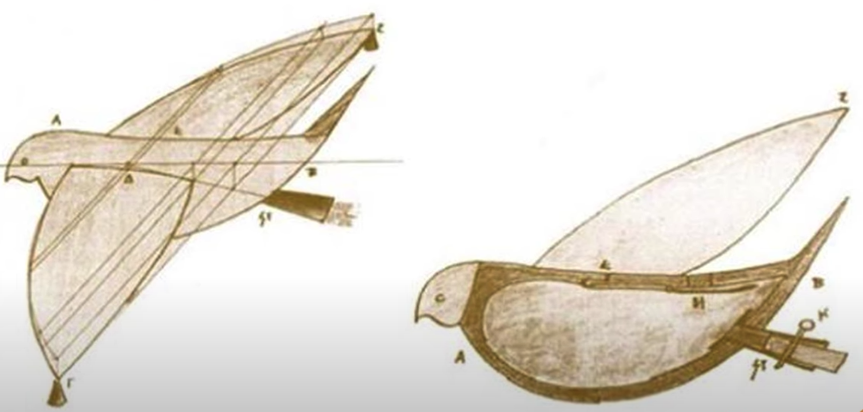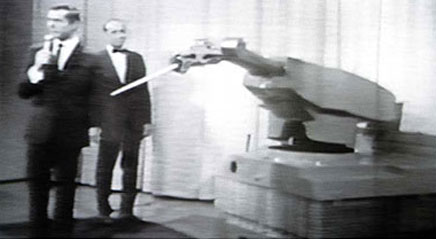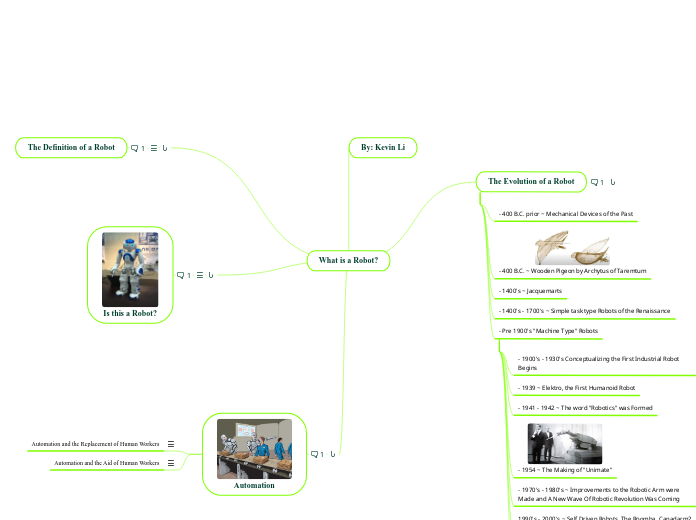What is a Robot?
By: Kevin Li
The Evolution of a Robot
- 400 B.C. prior ~ Mechanical Devices of the Past

- 400 B.C. ~ Wooden Pigeon by Archytus of Taremtum
- 1400's ~ Jacquemarts
- 1400's - 1700's ~ Simple task type Robots of the Renaissance
- Pre 1900's "Machine Type" Robots
- 1900's - 1930's Conceptualizing the First Industrial Robot Begins
- 1939 ~ Elektro, the First Humanoid Robot
- 1941 - 1942 ~ The word "Robotics" was Formed

- 1954 ~ The Making of "Unimate"
- 1970's - 1980's ~ Improvements to the Robotic Arm were Made and A New Wave Of Robotic Revolution Was Coming
1990's - 2000's ~ Self Driven Robots, The Roomba, Canadarm2, Entertainment Robots
2000's - Present Day ~ Robotics, New Improvements, FRC, Accessibility, and Computing Technology
2020's and Onward ~ The Future?
The Definition of a Robot
The definition of a ‘Robot,’ as stated from Britannica.com, says “robot, any automatically operated machine that replaces human effort, though it may not resemble human beings in appearance or perform functions in a humanlike manner. By extension, robotics is the engineering discipline dealing with the design, construction, and operation of robots, (Moravec H.).”In my own words, I would consider something to be a robot if a machine is designed to autonomously move on its own after given input, and/or it uses its own base knowledge to comprehend a situation. Ex. An A.I. designed to recognize faces will use already known faces to become capable of seeing new ones. A chassis on wheels is powered by a motor and its only function is to drive forward. This would still be considered a robot because its function/its "program" is to make the motor spin in one direction when powered on. It therefore accomplishes its task to drive forward.
aIs this a Robot?
Is this considered a Robot?(Image taken from Ubahnverleih, under Creative Commons CC0 1.0 Universal Public Domain Dedication, 2016)Is this?(Image take from the Canadian Space Agency, NASA,2020)Is this?(Image taken from DesignRobotics.net,2018)
ad
Automation
Automation and the Replacement of Human Workers
When the idea of self operating machines first came to light in the early 1400’s, people mainly saw them as a form of entertainment. In the present day, for many people in the industry, and throughout the world, the fear of Technology and Robots taking over the industry is very present. Due to the steadily declining cost of electronic materials and the ease of access for parts from home 3D printers, the increase in people designing/making robots and other mechanized creations has been on the rise; for better or for worse. What’s the reason for the fear? For certain people, it can be because of the fear that a computer will perform a task much more efficiently than by hand, and will also be more consistent. Originally, Robots were much less complicated, either only able to do one task at a time, only one task, or little to no adaptability. They were designed to handle only one situation, so if a problem ever appeared, they wouldn’t be able to solve it. Then, computer functionality improved, and the birth of programming languages and actual development was made possible. Robots started to gain intelligence; able to perform tasks that were unknown to them simply by using their already existing knowledge. This became Artificial Intelligence. (A.I.). Now comes the problem. If we hypothetically created a robot that could pick-up resources, serve customers, or even bake a cake, we now have that crisis that people are imagining. If a robot can pick-up resources, the harm that could potentially happen if said robot were a human wouldn’t be possible. These robots could also have stronger motors than a human arm, and if they were situated on wheels, they would be a lot steadier. Serving customers means that they can retain more orders for customers at once, and minimize mistakes. Baking a cake would be the equivalent of an automatic bakery. The need for learning to cook would be unnecessary and the recipe would be perfect every time. This is the problem that people see.
Automation and the Aid of Human Workers
However, it wouldn’t be fair to say that robots are just going to solve everyone’s problems. A.I. does have limitations. For example, to get an A.I. to understand what any arbitrary item is, it has to have it in its own database. You could give it access to a cloud, or just fill its computer chip with data on as many things as possible. But, that doesn’t make it human, and it won’t be able to learn more objects, without human input, so that means someone would still be working to make sure that a robot dealing with unknown substances knew what it was handling, and did it appropriately. The solution would be to give it knowledge through simulation. Running the best “genomes” together to create the perfect robot for a task. And that might be why companies are trying to implement more technology in their systems. With the help of robots, we could potentially be minimizing the amount of waste that is made by each product, and the energy expended. People could then spend more time optimizing their machines instead of being the machine. The need for people to repair a robot is also present. You cannot just let a robot run forever. Eventually something might go wrong, or it might be doing the wrong thing the whole time. The only way to know would be to have someone experienced in the occupation to observe and provide feedback. Not only that, but the programmer must have background knowledge on the task they’re programming, or someone else has to explain the task to them. Even if you theorize all the steps and program it, you won’t know how good it is until it is actually put into action and you can see if it’s really being efficient or not. The global population can also be a factor. Having multiple people to monitor whether the factory employees are on task can be very difficult, as factories have many sections and jobs, and people that need to be checked. It can also be difficult to tell if someone needs a break or not, as humans all act differently. When you have a bunch of automated systems, information about each device can be easily provided and monitored at all times, so if something is faulty, finding the faulty device and repairing it is much easier. People also wouldn’t have to work as long shifts with the help of robotics. Also, with the help of computers, human error is heavily minimized, which helps prevent accidents from occuring. But the other side of things is that if we rely too much on robots, people will lose the ability in the actual skills needed that were replaced by the robots. I.e. to build a welding machine, you need to know how to weld/how welding works. At the same time, because our population will likely continue to grow up to 10 billion people, people who are less experienced might find it harder to find a job that doesn’t involve designing/repairing robots. Therefore, I believe that we could achieve a healthy balance of both robots, and people. Robots to handle delicate and difficult tasks, and humans to monitor, and perform the skilled trades that no real amount of robotics can accomplish. Like a smartphone, its job is not to become your life. It’s a tool to help you with your life; to make it easier.
